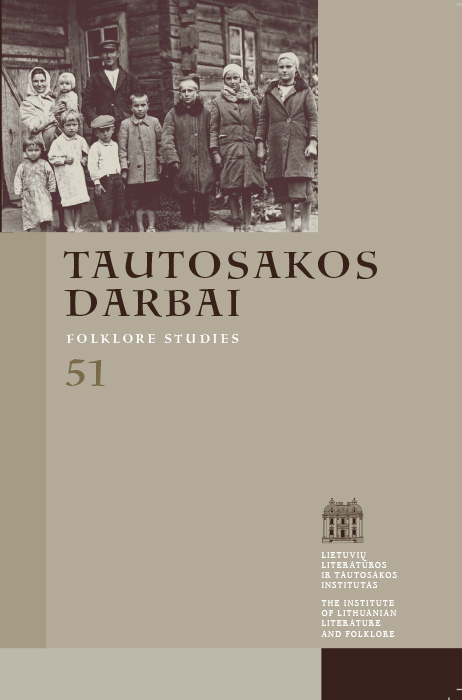Susapnuota bendrystė: namiškių ryšiai tradiciniuose sapnų pasakojimuose
Santrauka
Gausiausią fiksuojamų folklorinių sapnų naratyvų dalį sudaro pasakojimai apie susapnuotus šeimos ar giminės artimuosius. Gyvųjų ir mirusiųjų namiškių santykiai vyresniųjų kartų pasakotojų apsakomi prisilaikant tradicinių bendruomenės gyvenimo normų ir tvarkos: kalbama apie sapnuose kartu dirbamus darbus, įvairius mirusiųjų prašymus ir jų paakinimus, ką gyvieji turėtų daryti ir ko šiukštu nedaryti konkrečiais gyvenimo atvejais, patarimus, ko tikėtis ir kuo tikėti. Šios daugialypės tradicinės laikysenos įvardytinos kaip bendruomenėje vyraujančių religinių praktikų, nusistovėjusių papročių bei artimų žmonių ryšių išraiška ir atspindys. Atokiau paliekant šiuolaikiniuose oneiriniuose tyrimuose neretai aktualinamą mistiškąjį susitikimų su artimaisiais sapnuose aspektą ir tradicinei liaudiškajai žinijai priskiriamas sapnų reikšmių interpretacijas, straipsnyje siekiama atidžiau pasigilinti, kokius emocinius išgyvenimus sapnų pasakotojams ir klausytojams sukelia, kokius veiksmus paskatina tokio pobūdžio sapniškosios patirtys.
Tradicinių sapnų pasakojimų apibrėžtis straipsnyje pasirenkama kryptingai, norint akcentuoti folklorines, o ne psichologines jų tyrimo prieigas, taip pat siekiant tegu ir punktyrais nužymėti nagrinėjamą medžiagą, kurią šiuo atveju sudaro dar palyginti gyvai bendruomeninio sambūvio turinį atspindintys folkloro lauko tyrimų metu užrašyti vyresniųjų žmonių pasakojimai ir tekstai iš įvairaus pobūdžio spausdintų šaltinių.
Atsisiuntimai
Skaitomiausi šio autoriaus(ų) straipsniai
- Austė Nakienė, Radvilė Racėnaitė, Vita Ivanauskaitė-Šeibutienė, Rytis Ambrazevičius, Lina Būgienė, Gražina Kadžytė, Rima Visackienė, Irena Žilienė, Andželika Jakubynienė, Kronika , Tautosakos darbai: T 52 (2016)
- Vita Ivanauskaitė-Šeibutienė, Laiškai tartum Dievo pyragai. Vyskupo Teofiliaus Matulionio epistolinio palikimo knyga , Tautosakos darbai: T 68 (2024): Tautosakos darbai
- Vita Ivanauskaitė-Šeibutienė, Skambanti užstalė: vaišių dainos tradiciniuose bendruomenės sambūriuose , Tautosakos darbai: T 50 (2015)
- Vida Norvaišienė, Dainius Razauskas, Rūta Žarskienė, Vita Ivanauskaitė-Šeibutienė, Lina Būgienė, Kronika , Tautosakos darbai: T 49 (2015)
- Vita Ivanauskaitė-Šeibutienė, Didžiosios dainų knygos: lietuvių dainynų mokslinės edicijos pradmenys brolių Juškų folkloro publikacijose , Tautosakos darbai: T 57 (2019)
- Audronė Gedžiūtė, Jūratė Šlekonytė, Jurgita Ūsaitytė, Vita Ivanauskaitė-Šeibutienė, Kronika , Tautosakos darbai: T 57 (2019)
- Vita Ivanauskaitė-Šeibutienė, Tradicijos refleksija dailininko raštuose, arba Besimokant antropologijos iš Stasio Eidrigevičiaus , Tautosakos darbai: T 55 (2018)
- Guntis Pakalnas, Rimantas Sliužinskas, Asta Skujytė-Razmienė, Radvilė Racėnaitė, Vita Ivanauskaitė-Šeibutienė, Rūta Žarskienė, Lina Leparskienė, Andželika Jakubynienė, Kronika , Tautosakos darbai: T 47 (2014)
- Vita Ivanauskaitė-Šeibutienė, Folklorinė sapno kalba: oneiriniai naratyvai bendruomeninėje komunikacijoje , Tautosakos darbai: T 48 (2014)
- Vita Ivanauskaitė-Šeibutienė, LITUANUS: The Lithuanian Quarterly Journal of Arts and Sciences, vol. 60:4, Winter 2014 , Tautosakos darbai: T 49 (2015)
